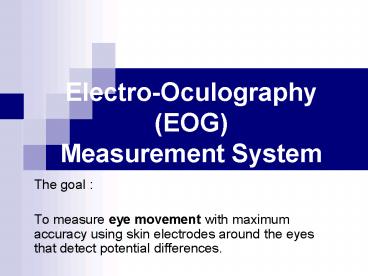Electro-Oculography (EOG) Measurement System - PowerPoint PPT Presentation
1 / 23
Title:
Electro-Oculography (EOG) Measurement System
Description:
Electro-Oculography (EOG) Measurement System The goal : To measure eye movement with maximum accuracy using skin electrodes around the eyes that detect potential ... – PowerPoint PPT presentation
Number of Views:245
Avg rating:3.0/5.0
Title: Electro-Oculography (EOG) Measurement System
1
Electro-Oculography (EOG)Measurement System
- The goal
- To measure eye movement with maximum accuracy
using skin electrodes around the eyes that detect
potential differences.
2
Types of Eye Movement (1)
- Saccades
- Quick jumps that connect fixations
- Duration is typically between 30 and 120 ms
- Very fast (up to 700 degrees/second)
- Saccades are ballistic, i.e., the target of a
saccade cannot be changed during the movement. - Saccades are used to move the fovea to the next
object/region of interest.
3
Types of Eye Movement (2)
- Smooth Pursuit Eye Movements
- Smooth movement of the eyes for visually tracking
a moving object - Cannot be performed in static scenes
(fixation/saccade behavior instead)
- Torsional (?????) Eye Movements
- Rotation of the eye around the viewing axis
- Stabilization of visual scene by compensating
body rotation - (up to about 15 degrees)
4
Types of Eye Movement (3)
- Tremor (?????)
- Fast, low-amplitude (seconds of arc) eye-movement
jitter - Improves the perception of high spatial
frequencies
- Vergence (?????) Eye Movements
- changing the vergence angle (the angle between
the two viewing axes) by slow, smooth
movement of the two eyes in opposite directions. - Used for changing gaze from a near to a far
object or vice versa - Can take up to one second
In this project we try to measure only Saccades
movements using EOG !
5
EOG
The electrical potentials around the eyes arise
due to the permanent potential difference of
between 10 and 30mV that exists between the
cornea and the ocular fundus. This is commonly
referred to as the cornea-retinal potential with
the cornea being positive.
6
? EOG - How it works
Human eye (top view)
Left
Right
100 uV
-100 uV
Voltmeter
7
Placing the electrodes (1)
- Horizontal eye movements can be best measured by
placing the electrodes on the left and right
external canthi (the bone on the side of the eye).
- Vertical movements of the eyes are measured by
placing the electrodes approximately one
centimetre vertically above and below the eye
8
Placing the electrodes (2)
- A reference electrode is positioned on the
subjects forehead
- A combination of the following is also possible
in order to measure horizontal and vertical
movements simultaneously. - By looking at the difference of Signal 1 and
Signal 2and the difference of Signal 3 and
Signal 4,a separation of horizontal and vertical
eye movements can be made.
4
1
2
3
9
Horizontal vs. Vertical
- The red graph on the top shows Signal 1
Signal 2 and therefore it reflects - only horizontal eye movements (Right Left)
- The blue graph on the bottom shows Signal 3
Signal 4 and therefore it reflects - only vertical eye movements (Up Down)
10
Our Equipment (1)
- In this project we had the PC-ECG device for
acquiring EOG signals. - PC-ECG does the following
- Amplification of the EOG signal
- 12 bit / 2kHz sampling
- And some more ?
11
Our Equipment (2)
- The PC-ECG system has a pole in the origin
- In such system
12
The Problem
- The PC-ECG device can not transmit DC signals.
- EOG signal is a partially constant function
13
Software Inverse System (1)
- The idea
- If we can characterize the PC-ECG system, in
other words find its impulse response - ,
the we can implement in software the inverse
system - and cancel the unwanted affect (cancel the zero
in the origin).
14
Software Inverse System (2)
- PC-ECG characterization
- Making recordings from eyes/signal generator we
got - Basically now we know the step response of
the PC-ECG system. - Consequently the impulse response that describes
the system - is .
- Therefore
15
Software Inverse System (3)
- Finding the Inverse System
After converting to discrete time by using the
rectangle approximation, we get
16
Software Inverse System (4)
- The Results
17
Software Inverse System (5)
- The good news
- The Software Inverse System was able to bring the
signal back to its original "Square Sine" form,
which was produced by the Signal Generator. - The bad news
- Although by using the Software
- Inverse System we are able to
- correct the signal to its
- original form, the entire system
- is unstable!
18
Horizontal Eye Tracker (HET)
- The software that we have developed does in Real
Time the following things - Data acquisition from the PC-ECG device 12
bit, 2000 Samples/sec - LPF filtering of the raw signal, with cutoff
frequency of approximately 30Hz - Applying the inverse system on the filtered
signal. - Makes auto calibration and periodic
centralization of corrected signal in order to
overcome the instability problem. - Marks in red the appropriate button (Left, Center
or Right) according to the corrected signal level.
19
Periodic centralization (1)
- Problem 1
20
Periodic centralization (2)
- Solution 1
21
Periodic centralization (3)
- Problem 2
22
Periodic centralization (4)
- Solution 2
23
This is how it works
Digital Signal, 12bits / 2 kHz
Analog Signal, Amplitude 100 uV
The subject gets a feedback by seeing that the
button that he is looking at becomes red.































